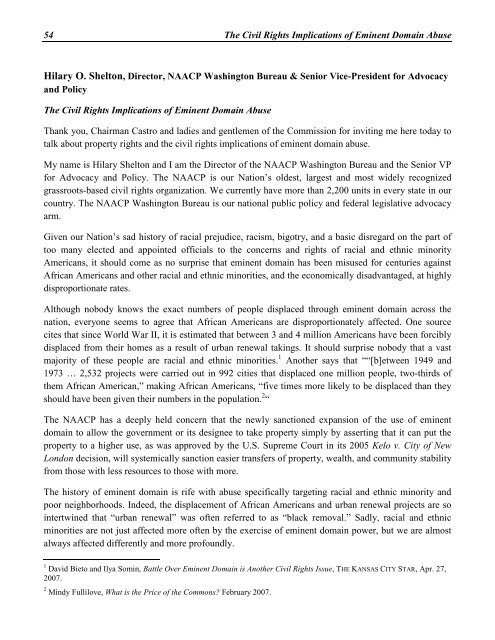Create successful ePaper yourself
Turn your PDF publications into a flip-book with our unique Google optimized e-Paper software.
54 The Civil Rights Implications of <strong>Eminent</strong> <strong>Domain</strong> AbuseHilary O. Shelton, Director, NAACP Washington Bureau & Senior Vice-President for Advocacyand PolicyThe Civil Rights Implications of <strong>Eminent</strong> <strong>Domain</strong> AbuseThank you, Chairman Castro and ladies and gentlemen of the Commission for inviting me here today totalk about property rights and the civil rights implications of eminent domain abuse.My name is Hilary Shelton and I am the Director of the NAACP Washington Bureau and the Senior VPfor Advocacy and Policy. The NAACP is our Nation’s oldest, largest and most widely recognizedgrassroots-based civil rights organization. We currently have more than 2,200 units in every state in ourcountry. The NAACP Washington Bureau is our national public policy and federal legislative advocacyarm.Given our Nation’s sad history of racial prejudice, racism, bigotry, and a basic disregard on the part oftoo many elected and appointed officials to the concerns and rights of racial and ethnic minorityAmericans, it should come as no surprise that eminent domain has been misused for centuries againstAfrican Americans and other racial and ethnic minorities, and the economically disadvantaged, at highlydisproportionate rates.Although nobody knows the exact numbers of people displaced through eminent domain across thenation, everyone seems to agree that African Americans are disproportionately affected. One sourcecites that since World War II, it is estimated that between 3 and 4 million Americans have been forciblydisplaced from their homes as a result of urban renewal takings. It should surprise nobody that a vastmajority of these people are racial and ethnic minorities. 1 Another says that ““[b]etween 1949 and1973 … 2,532 projects were carried out in 992 cities that displaced one million people, two-thirds ofthem African American,” making African Americans, “five times more likely to be displaced than theyshould have been given their numbers in the population. 2 “The NAACP has a deeply held concern that the newly sanctioned expansion of the use of eminentdomain to allow the government or its designee to take property simply by asserting that it can put theproperty to a higher use, as was approved by the U.S. Supreme Court in its 2005 Kelo v. City of NewLondon decision, will systemically sanction easier transfers of property, wealth, and community stabilityfrom those with less resources to those with more.The history of eminent domain is rife with abuse specifically targeting racial and ethnic minority andpoor neighborhoods. Indeed, the displacement of African Americans and urban renewal projects are sointertwined that “urban renewal” was often referred to as “black removal.” Sadly, racial and ethnicminorities are not just affected more often by the exercise of eminent domain power, but we are almostalways affected differently and more profoundly.1 David Bieto and Ilya Somin, Battle Over <strong>Eminent</strong> <strong>Domain</strong> is Another Civil Rights Issue, THE KANSAS CITY STAR, Apr. 27,2007.2 Mindy Fullilove, What is the Price of the Commons? February 2007.


